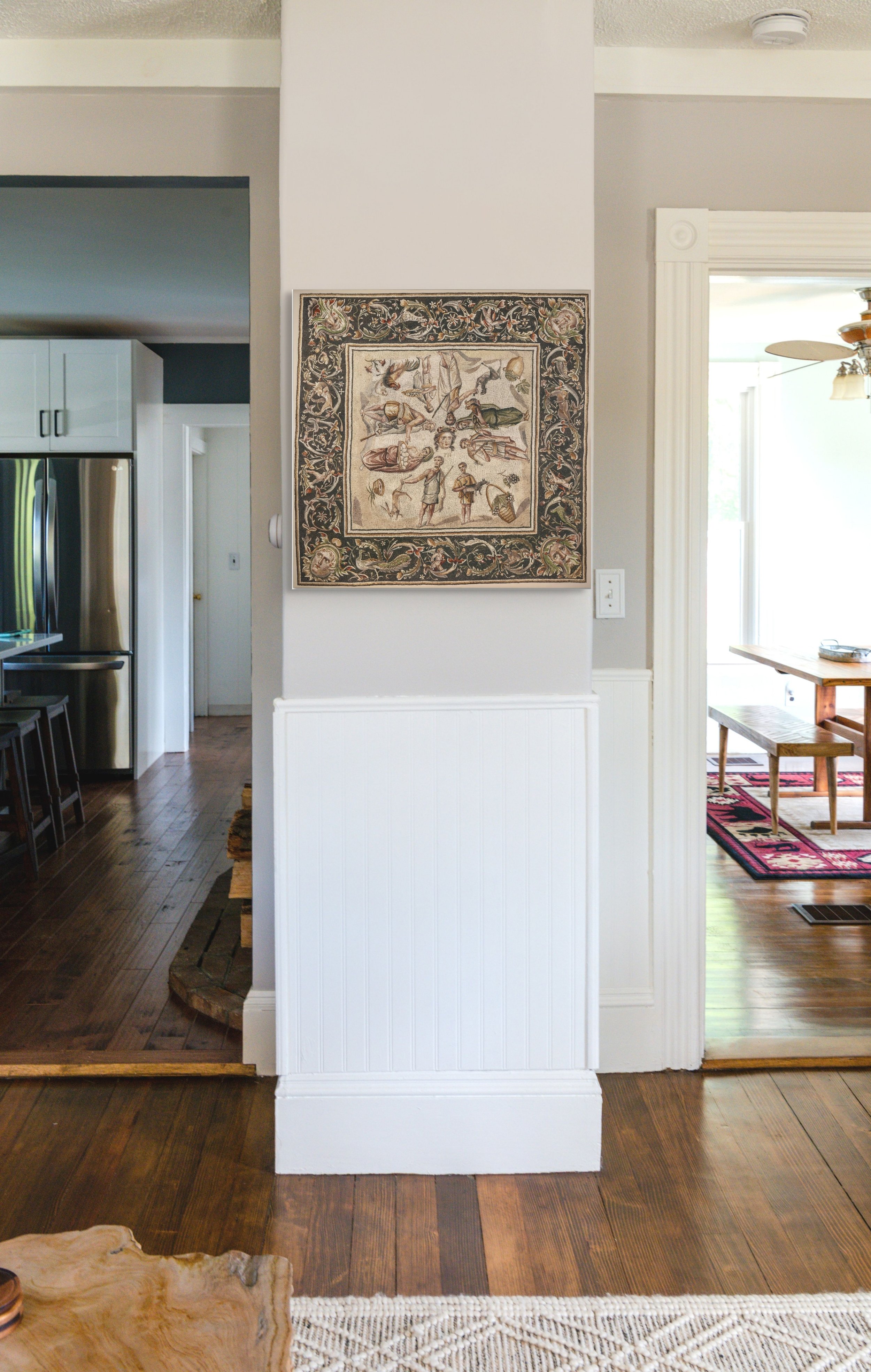 Image 1 of 2
Image 1 of 2

 Image 2 of 2
Image 2 of 2



Printed Canvas on Wood of Roman Market Scene
The central ornamentation shows a market scene. Eight male figures of different ages, each dressed in a short tunic or in a toga, are positioned harmoniously on all four sides of the square central panel. Each carries or presents a different product: a hare, a young wild boar, a deer, a brace of pheasants, a kid goat, a rooster and a hen, a brace of partridges, fruit and/or buns in baskets.
All these elements embody products offered by Mother Earth, whose personification is symbolized at the center of the mosaic through a female face. Together with the theme, the inscription in ancient Greek can leave no doubt about her identification: Gh.
As for the outer border, it is strongly emphasized by a plant pattern composed of flowers and fruit in a dense green foliage. Small winged erotes, each armed with a bow and arrow, are depicted on each of the four sides of the mosaic. They hunt a variety of prey, such as peacock, partridge, deer, panther and even lion (one is already wounded by an arrow shot by one of the erotes).
In the corners, the traditional faces and masks are present; two men and, perhaps, two women are featured in opposite corners. Their plant-like hair fits perfectly into the thematic framework of the mosaic, representing pastoral divinities.
The very large size, the theme (a genre scene) and the technique of this mosaic suggest that it was produced in the eastern part of the Roman Empire. Large-scale figural representations are actually typically Levantine productions. Our example probably decorated a private residence and would have been specially commissioned by the owners, because mythological scenes were much more common than daily life representations.
The central ornamentation shows a market scene. Eight male figures of different ages, each dressed in a short tunic or in a toga, are positioned harmoniously on all four sides of the square central panel. Each carries or presents a different product: a hare, a young wild boar, a deer, a brace of pheasants, a kid goat, a rooster and a hen, a brace of partridges, fruit and/or buns in baskets.
All these elements embody products offered by Mother Earth, whose personification is symbolized at the center of the mosaic through a female face. Together with the theme, the inscription in ancient Greek can leave no doubt about her identification: Gh.
As for the outer border, it is strongly emphasized by a plant pattern composed of flowers and fruit in a dense green foliage. Small winged erotes, each armed with a bow and arrow, are depicted on each of the four sides of the mosaic. They hunt a variety of prey, such as peacock, partridge, deer, panther and even lion (one is already wounded by an arrow shot by one of the erotes).
In the corners, the traditional faces and masks are present; two men and, perhaps, two women are featured in opposite corners. Their plant-like hair fits perfectly into the thematic framework of the mosaic, representing pastoral divinities.
The very large size, the theme (a genre scene) and the technique of this mosaic suggest that it was produced in the eastern part of the Roman Empire. Large-scale figural representations are actually typically Levantine productions. Our example probably decorated a private residence and would have been specially commissioned by the owners, because mythological scenes were much more common than daily life representations.
The central ornamentation shows a market scene. Eight male figures of different ages, each dressed in a short tunic or in a toga, are positioned harmoniously on all four sides of the square central panel. Each carries or presents a different product: a hare, a young wild boar, a deer, a brace of pheasants, a kid goat, a rooster and a hen, a brace of partridges, fruit and/or buns in baskets.
All these elements embody products offered by Mother Earth, whose personification is symbolized at the center of the mosaic through a female face. Together with the theme, the inscription in ancient Greek can leave no doubt about her identification: Gh.
As for the outer border, it is strongly emphasized by a plant pattern composed of flowers and fruit in a dense green foliage. Small winged erotes, each armed with a bow and arrow, are depicted on each of the four sides of the mosaic. They hunt a variety of prey, such as peacock, partridge, deer, panther and even lion (one is already wounded by an arrow shot by one of the erotes).
In the corners, the traditional faces and masks are present; two men and, perhaps, two women are featured in opposite corners. Their plant-like hair fits perfectly into the thematic framework of the mosaic, representing pastoral divinities.
The very large size, the theme (a genre scene) and the technique of this mosaic suggest that it was produced in the eastern part of the Roman Empire. Large-scale figural representations are actually typically Levantine productions. Our example probably decorated a private residence and would have been specially commissioned by the owners, because mythological scenes were much more common than daily life representations.
Information:
Printed cotton canvas on wooden frame
25x25in (64x64cm) or 20x20in (51x51cm)


